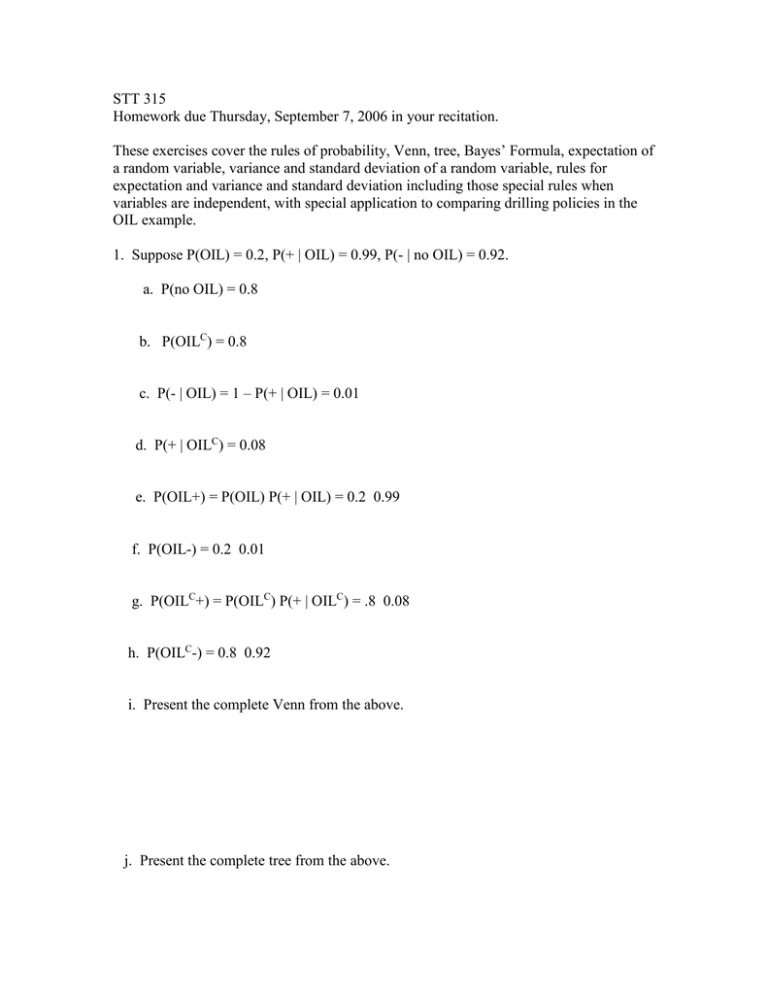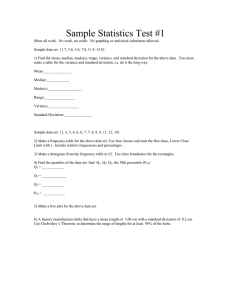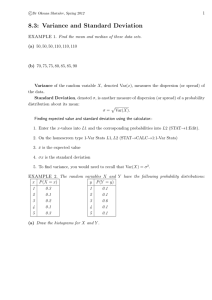STT 315 Homework due Thursday, September 7, 2006 in your recitation.
advertisement

STT 315 Homework due Thursday, September 7, 2006 in your recitation. These exercises cover the rules of probability, Venn, tree, Bayes’ Formula, expectation of a random variable, variance and standard deviation of a random variable, rules for expectation and variance and standard deviation including those special rules when variables are independent, with special application to comparing drilling policies in the OIL example. 1. Suppose P(OIL) = 0.2, P(+ | OIL) = 0.99, P(- | no OIL) = 0.92. a. P(no OIL) = 0.8 b. P(OILC) = 0.8 c. P(- | OIL) = 1 – P(+ | OIL) = 0.01 d. P(+ | OILC) = 0.08 e. P(OIL+) = P(OIL) P(+ | OIL) = 0.2 0.99 f. P(OIL-) = 0.2 0.01 g. P(OILC+) = P(OILC) P(+ | OILC) = .8 0.08 h. P(OILC-) = 0.8 0.92 i. Present the complete Venn from the above. j. Present the complete tree from the above. k. P(OIL | +) = P(OIL+) / P(+) by definition = 0.2 0.99 / (0.2 0.99 + 0.8 0.08) l. P(OIL | -) = P(OIL-) / P(-) = 0.2 0.01 / (0.2 0.01 + 0.8 0.92) m. P(OILC | +) from (k) = 1 – P(OIL | +) = 1 - 0.2 0.99 / (0.2 0.99 + 0.8 0.08) 2. Refer to (1j). Suppose the cost to test is 20, the cost to drill is 45, and the gross return from oil is 500 (but you have to drill and oil has to be there otherwise the gross return is 0). a. Calculate E X where random variable X denotes the net return from the policy “do not test, just drill.” Here we either have oil or not, there is no need to incorporate testing in the model. x OIL 0.2 -45 + 500 = 455 no OIL 0.8 -45 + 0 = -45 E X = (455 0.2 - 45 0.8) = 55. b. Calculate E Y where random variable Y denotes the net return from the policy “pay to test but only drill if the test turns out +.” Which policy has the largest expected net return? Here we must incorporate the “test” into the model. y OIL+ 0.2 0.99 -20 – 45 + 500 = 435 OIL- 0.2 0.01 -20 – 0 + 0 = -20 OILC+ 0.8 0.08 -20 – 45 + 0 = -65 OILC - 0.8 0.92 -20 – 0 + 0 = -20 E Y = 435 0.2 0.99 - 20 0.2 0.01 – 65 0.8 0.08 – 20 0.8 0.92 = 67.21 (greater than E X = 55 for the “just drill” policy). 3. The distribution of a random variable W (list of values w and their probabilities p(w)) is given below. w p(w) w p(w) w2 p(w) (w – EW)2 p(w) ___________________________________________________________________ 2 0.4 2(.4) = 0.8 22 (.4) = 1.6 (2 – 4.2)2 0.4 = 1.936 4 0.1 4(.1) = 0.4 42 (.1) = 1.6 (4 – 4.2)2 0.1 = 0.004 6. 0.5 6(.5) = 3 62(.5) = 18 (6 – 4.2)2 0.5 = 1.62 ___________________________________________________________________ totals 1.0 E W = 4.2 E W2 = 21.2 Variance W = 3.56 Notice that Var X = E W2 – (E W)2 = 21.2 – (4.2)2 = 3.56 (computing formula). a. Calculate E W. Plot the distribution (i.e. plot of value w on the horizontal axis and its probability p(w) on the vertical axis. E W is necessarily the “balance point” of the distribution. Does this appear to be true just from looking at it? b. Calculate E (W2) (we usually just write E W2 ). This is the “expected square of W.” c. Calculate Variance W = E (W2) – (E W)2. This is the “expected square minus the square of the expectation.” Variance of W has a role to play in how volatile repeated samples of W will be. d. Standard deviation of W is defined to be the square root of variance of W. What is the standard deviation of random variable W? root(3.56) e. Calculate Variance W from the final column above. 3. Rules of E. Random variables X, Y have E X = 2.3, E Y = 5.4. a. E(X + Y) = E X + E Y = 2.3 + 5.4 b. E(Y – X) = E Y – E X = 5.4 – 2.3 c. E(2 X + Y – 4) = 2 E X + E Y – 4 = 2(2.3) + 5.4 - 4 4. Rules of Variance. Refer to (3). Suppose Variance X = 2, Variance Y = 3. a. We cannot in general say what E (XY) is. If, however, X is independent of Y we can determine E (XY). What is its value if X is independent of Y? E(X Y) = (E X) (E Y) if X, Y independent. = (2.3) (5.4) from (3). b. What does it mean for random variables to be independent? For all possible values x, y we have P(Y = y | X = x) = P(Y = y). It means that nothing we may learn concerning X will alter the probabilities for Y (or visa-versa). e.g. X = weight upon rising tomorrow is (likely to be) independent of Y = number of orders for egg drop soup in Shanghai next year. Likewise, X = my earnings on pull one of the slot machine is (likely to be) independent of my earnings on pull two of the slot machine. On the other hand, my weight upon rising tomorrow may be dependent with that of my wife since we share the same meal and might eat a large meal together or go for a lighter meal together. It seems reasonable that sales of Coke and Pepsi are dependent but the precise nature of that dependence is clouded (they may rise and fall together on the state of consumer spending but one may rise at the expense of the other in a tight market or in response to one company’s advertising push). c. If X, Y are independent what then is Variance(X + Y)? Var(X + Y) = Var X + Var Y for independent random variables. = 2 + 3 from the information given above. d. Refer to (c). What is standard deviation of X+Y? root(2 + 3) e. Refer to (c). What is standard deviation of (7X+6)? Var(7 X + 6) = Var(7 X) (adding 6 does not alter deviations from avg) = 49 Var(X) = 49 2 = 98 (coeff of 7 comes out as the square) So std dev of (7 X + 6) = 7 std dev X = 7 root(2) f. Refer to (c). What is standard deviation of (5 X – 4Y + 3)? root(25 2 + 16 3)







